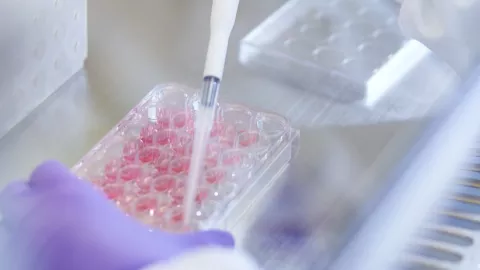
Natalizumab
Natalizumab (Tysabri) is already licensed to treat highly active relapsing MS. It's been trialled for people with progressive MS.
- Current phase of trial:
- Phase 2/3.
Find out more about natalizumab
How does natalizumab work?
Natalizumab is an antibody, just like those found in the immune system (where antibodies help fight infection). By attaching itself to receptors on the outside of certain immune cells, natalizumab prevents these cells from leaving the bloodstream and entering the brain and spinal cord. This stops them from causing damage and inflammation in MS.
How is natalizumab taken?
Natalizumab is an intravenous infusion.
Latest research
ASCEND - phase 3 trial in secondary progressive MS
The ASCEND trial involved 890 people with secondary progressive MS and tested if natalizumab can slow accumulation of disability in secondary progressive MS. Disability was measured using the Expanded Disability Status Scale, which mainly focuses on walking. Researchers also measured arm and hand function using the 9-Hole Peg Test.
The company behind this trial (Biogen) announced that the drug had failed to meet its main endpoint in October 2015. Although the treatment had no effect on walking, it was found to significantly improve arm and hand function.
In April 2017 long term study results were announced. 566 people were followed up in an open-label study for up to three years after the trial had ended. Natalizumab was found to slow disability progression in people with advanced secondary progressive MS.
NAPMS - phase 2 trial in progressive MS
The NAPMS trial involved 24 people with progressive MS. Researchers measured the amount of inflammation using a biomarker found in the spinal fluid of people with MS. They found that people taking Tysabri had reduced levels of this biomarker compared with those taking placebo.
They concluded that Tysabri could be reducing inflammation in progressive MS.
What are the side effects of natalizumab?
Most people taking natalizumab tolerate it well, but there can be side effects – including a very rare, but potentially fatal infection called PML.
Common side effects
Common side effects include joint pain, fever, tiredness, a runny or blocked nose, sore throat, feeling or being sick, headache or dizziness.
Infusion related side effects
During the infusion of natalizumab, and up to an hour afterwards, some people shiver, or feel sick or dizzy. Around one in 25 people who take natalizumab have a more serious allergic reaction to taking it, either during the infusion or in the hour following. In addition, people might have skin reactions to the infusion.
PML
PML (progressive multifocal leukoencephalopathy) is caused by a viral infection in the brain. It can cause severe neurological symptoms, which may at first be mistaken for MS relapses. But the symptoms rapidly worsen and may lead to death or disability. Several people treated with natalizumab have died because of PML.
Analysis of the number of cases of PML suggests that the overall risk is about 1 in every 500 people treated with natalizumab.
Any hospital prescribing natalizumab must ensure that everyone – professionals and patients – is aware of the risks, the early signs of PML to look out for and what to do if they notice these signs.
There are some factors that are known to increase your risk of developing PML. Your neurologist should talk to you about those risk factors and how they affect you.
How does natalizumab compare with other therapies?
Natalizumab hasn’t yet been directly compared with other therapies for progressive MS.
When will natalizumab be available?
Natalizumab (Tysabri) is licensed to treat active relapsing MS, but right now the data is not strong enough for progressive MS. Phase 3 trials would need to show the benefits of natalizumab in progressive MS before it can be licensed.

